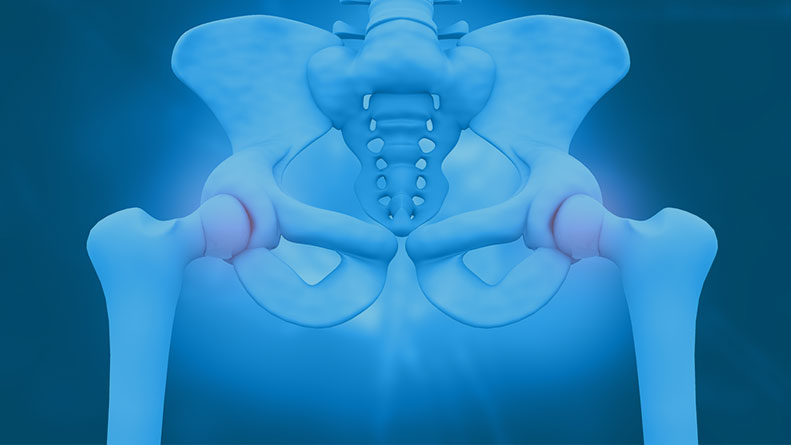
Understanding A Hip Injury
Hip Anatomy
The hip joint is the largest weight-bearing joint in the human body. It is also referred to as a ball and socket joint and is surrounded by muscles, ligaments, and tendons. The thighbone or femur and the pelvis join to form the hip joint.
Any injury or disease of the hip will adversely affect the joint’s range of motion and ability to bear weight.
The hip joint is made up of the following:
- Bones and joints
- Ligaments of the joint capsule
- Muscles and tendons
- Nerves and blood vessels that supply the bones and muscles of the hip
Hip Movements
All the anatomical parts of the hip work together to enable various movements. Hip movements include flexion, extension, abduction, adduction, circumduction, and hip rotation.
Bones & Joints
Ligaments
Muscles & Tendons
Nerves & Arteries
Bones & Joints
Bones and Joints of the Hip
The hip joint is the junction where the hip joins the leg to the trunk of the body. It is comprised of two bones: the thighbone or femur, and the pelvis, which is made up of three bones called ilium, ischium, and pubis.
The ball of the hip joint is made by the femoral head while the socket is formed by the acetabulum. The acetabulum is a deep, circular socket formed on the outer edge of the pelvis by the union of three bones: ilium, ischium, and pubis. The lower part of the ilium is attached by the pubis while the ischium is considerably behind the pubis. The stability of the hip is provided by the joint capsule or acetabulum and the muscles and ligaments that surround and support the hip joint.
The head of the femur rotates and glides within the acetabulum. A fibrocartilaginous lining called the labrum is attached to the acetabulum and further increases the depth of the socket.
The femur is one of the longest bones in the human body. The upper part of the thighbone consists of the femoral head, femoral neck, and greater and lesser trochanters. The head of the femur joins the pelvis (acetabulum) to form the hip joint. Next to the femoral neck, there are two protrusions known as greater and lesser trochanters which serve as sites of muscle attachment.
Articular cartilage is the thin, tough, flexible, and slippery surface lubricated by synovial fluid that covers the weight-bearing bones of the body. It enables smooth movements of the bones and reduces friction.
Ligaments
Ligaments of the Hip Joint
Ligaments are fibrous structures that connect bones to other bones. The hip joint is encircled with ligaments to provide stability to the hip by forming a dense and fibrous structure around the joint capsule. The ligaments adjoining the hip joint include:
- Iliofemoral ligament: This is a Y-shaped ligament that connects the pelvis to the femoral head at the front of the joint. It helps in limiting over-extension of the hip.
- Pubofemoral ligament: This is a triangular shaped ligament that extends between the upper portion of the pubis and the iliofemoral ligament. It attaches the pubis to the femoral head.
- Ischiofemoral ligament: This is a group of strong fibers that arise from the ischium behind the acetabulum and merge with the fibers of the joint capsule.
- Ligamentum teres: This is a small ligament that extends from the tip of the femoral head to the acetabulum. Although it has no role in hip movement, it does have a small artery within that supplies blood to a part of the femoral head.
- Acetabular labrum: The labrum is a fibrous cartilage ring which lines the acetabular socket. It deepens the cavity increasing the stability and strength
Muscles & Tendons
Muscles and Tendons of the Hip Joint
A long tendon called the iliotibial band runs along the femur from the hip to the knee, and serves as an attachment site for several hip muscles including the following:
- Gluteal: These are the muscles that form the buttocks. There are three muscles (gluteus minimus, gluteus maximus, and gluteus medius) that attach to the back of the pelvis and insert into the greater trochanter of the femur.
- Adductors: These muscles are in the thighs which help in adduction, the action of pulling the leg back towards the midline.
- Iliopsoas: This muscle is in front of the hip joint and provides flexion. It is a deep muscle that originates from the lower back and pelvis, and extends up to the inside surface of the upper part of the femur.
- Rectus femoris: This is the largest band of muscles located in front of the thigh. They are also called hip flexors.
- Hamstring muscles: These begin at the bottom of the pelvis and run down the back of the thigh. Because they cross the back of the hip joint, they help in extension of the hip by pulling it backwards.
Nerves & Arteries
Nerves and Arteries of the Hip Joint
Nerves of the hip transfer signals from the brain to the muscles to aid in hip movement. They also carry the sensory signals such as touch, pain, and temperature back to the brain.
The main nerves in the hip region include the femoral nerve in the front of the femur and the sciatic nerve at the back. The hip is also supplied by a smaller nerve known as the obturator nerve.
In addition to these nerves, there are blood vessels that supply blood to the lower limbs. The femoral artery, one of the largest arteries in the body, arises deep in the pelvis and can be felt in front of the upper thigh.
Conditions
Hip Osteoarthritis
Hip Osteoarthritis
What is Hip Osteoarthritis?
Osteoarthritis is a general term covering numerous conditions where the joint surface or cartilage wears out. The joint surface is covered by a smooth articular surface that allows pain-free movement in the joint. This surface can wear out for several reasons; often the definite cause is not known.
When the articular cartilage wears out, the bone ends rub on one another and cause pain. This condition is referred to as Osteoarthritis or “wear and tear” arthritis, as it occurs with aging and use. It is the most common type of arthritis. Dr. Gregory DiFelice specializes in diagnosing and treating osteoarthritis.
Causes of Hip Osteoarthritis
There are numerous conditions that can cause arthritis but often the exact cause is never known. In general, but not always, it affects people as they get older.
The causes include:
- Trauma, such as fractures
- Increased stress such as overuse or prior sports injuries
- Infection of the bone
- Connective tissue disorders
- Inactive lifestyle and being overweight. Your weight is the single most important link between diet and arthritis, as being overweight puts an additional burden on your hips, knees, ankles, and feet.
Symptoms of Hip Osteoarthritis
Hip osteoarthritis causes pain and decreased mobility of the hip joint. Patients often feel stiffness after prolonged sitting, which can eventually loosen up as they begin to walk. Pain is often focused to the deep groin.
Diagnosis of Hip Osteoarthritis
Dr. Gregory DiFelice will examine your hip, as well as, evaluate your symptoms and medical history before suggesting a treatment plan. Your initial evaluation will include an x-ray to evaluate the joint space in your hip. In the arthritic hip, the space between your femur (thigh bone) and your acetabulum (pelvis) will be narrower or absent. Additionally, bone spurs or excessive bone can also build up around the edges of the joint. The combinations of these factors make the arthritic knee stiff and limit activities due to pain or fatigue. An MRI scan may be performed to visualize the soft tissues better.
Treatment of Hip Osteoarthritis
The treatment depends on the degree of osteoarthritis, as well as, your age and activity level. If your osteoarthritis is minimal, or in the early stages, non-surgical treatment may be sufficient. Non-surgical treatment consists of rest, ice, compression, and elevation (RICE protocol). Physical therapy may be recommended to improve knee motion and strength. Injection therapy, including corticosteroids (hyperlink to injection page), can help patients with early to moderate osteoarthritis. However, if the symptoms do not resolve with non-surgical treatment, surgical treatment may be recommended.
Generally, surgery is considered in patients with persistent symptoms, despite conservative treatment. The definitive treatment for hip osteoarthritis is a total hip replacement, or arthroplasty. Dr.Gregory DiFelice performs this procedure using the posterior approach. During this procedure the arthritic portions of your hip joint will be removed and replaced with prosthetic hardware. For this procedure, you are usually in the hospital for about 2-3 days. Depending on your comfort level, you may be discharged home or to a local rehabilitation center. Following a total hip replacement, a rehabilitation program will be started that helps you resume a wider range of activities.
Following a total hip replacement, we recommend following “posterior hip approach” precautions for the first 12 weeks:
- Avoid combined movement of bending your hip and turning your foot inwards
- Keep a pillow between your legs while sleeping for 6 weeks
- Never cross your legs and bend your hips past a right angle (90 degrees)
- Avoid sitting on low chairs
- Avoid bending down to pick up things, instead a grabber can be used to do so
- Use an elevated toilet seat
For more information, please contact our office to schedule your appointment today.

